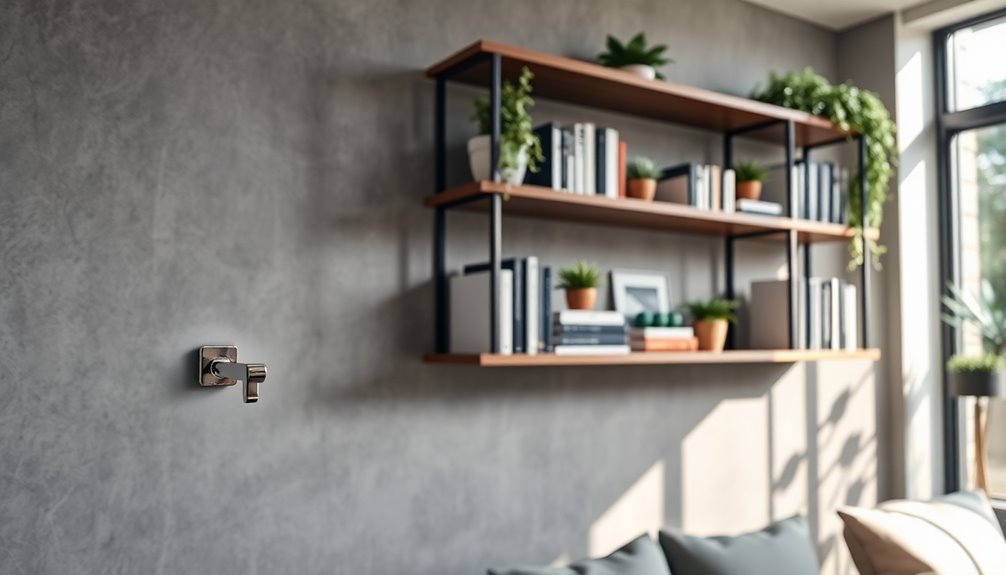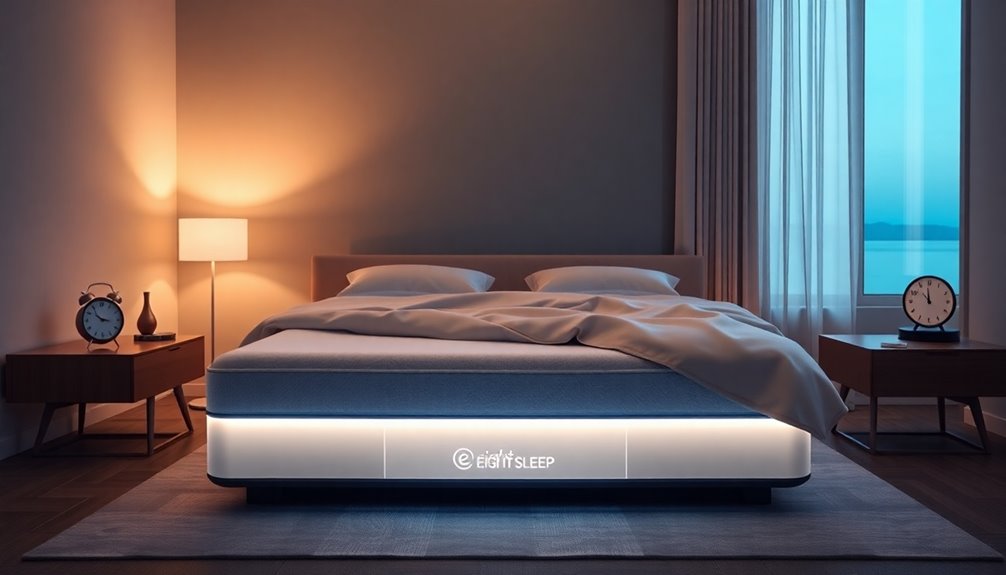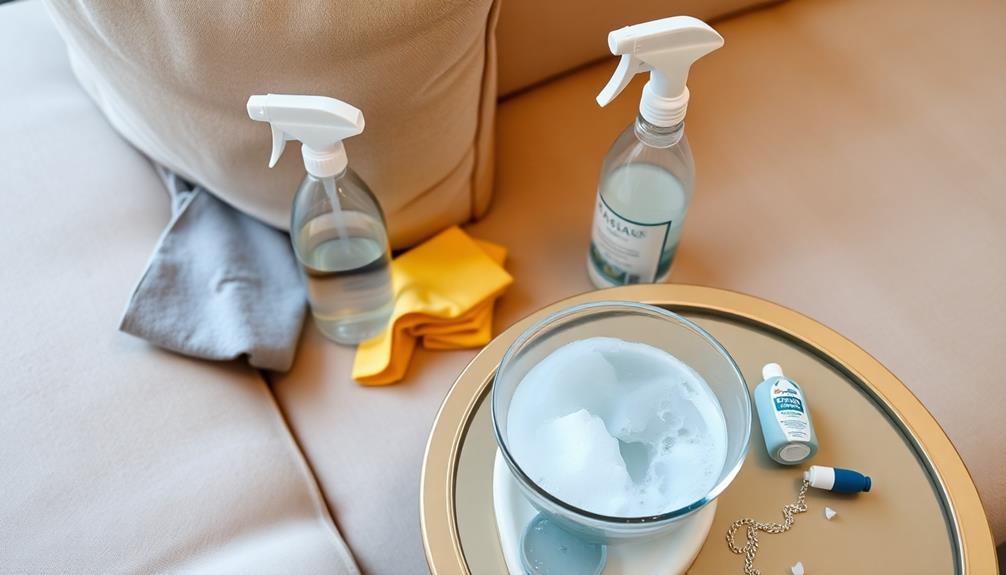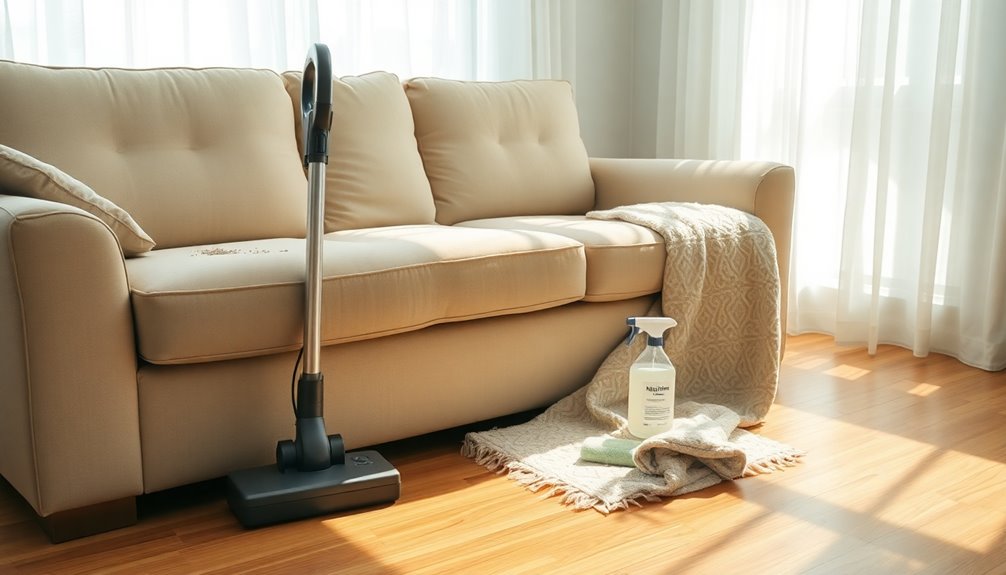To secure furniture to the wall, start by moving the furniture close to the wall. Use a stud finder to locate wall studs, as these are crucial for stability. Mark the stud locations and then drill pilot holes. Attach L-brackets or specialized anchors to both the wall and furniture, using screws at least two inches long for a strong hold. After installation, gently pull or push the furniture to test its stability. Don't forget to check your anchors regularly for signs of wear. There's plenty more to learn about ensuring your home is safe and secure.
Key Takeaways
- Use a stud finder to locate wall studs for secure anchoring of furniture to prevent tip-overs.
- Mark the desired positions on the wall and furniture with a pencil for accurate alignment.
- Drill pilot holes in both the wall and furniture, using appropriate anchors to ensure stability.
- Employ strong anchoring devices like L-brackets or specialized kits to maximize safety and prevent accidents.
- Regularly inspect and tighten anchors to maintain stability and ensure long-term safety.
Importance of Securing Furniture
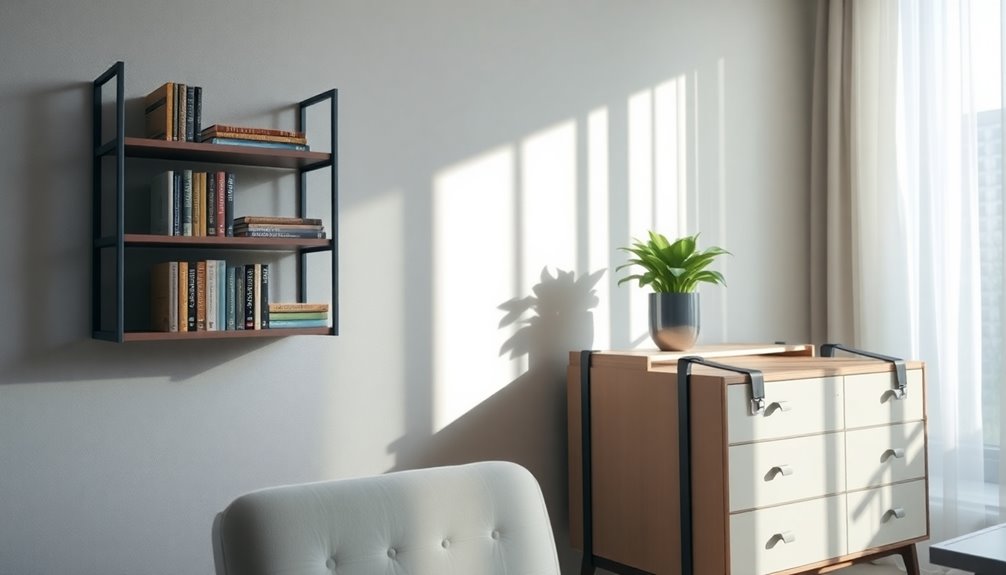
When it comes to keeping your home safe, securing furniture to the wall is essential. Furniture tip-overs can seriously injure or kill both children and adults, with someone rushing to the ER every hour due to these incidents. These accidents can happen with any type of furniture, regardless of its height, weight, or cost, making it crucial to take preventive measures. Small children are particularly at risk as they may climb on furniture, while older adults may not move quickly enough to avoid a falling piece.
The recent STURDY Act highlights the importance of stability by requiring certain dressers and furniture to pass safety tests and come with anchors. While this law applies to specific items, it doesn't cover all furniture types or protect older children and adults. Therefore, it's vital to secure all furniture, including TVs and appliances, to prevent tip-over accidents. Annually, there are over 11,000 injuries reported in the U.S. due to furniture tip-overs, emphasizing the need for vigilance in home safety. Regularly checking the anchors for security and ensuring all furniture is anchored can provide peace of mind. By taking these steps, you can significantly reduce the risk of serious injuries or fatalities in your home, creating a safer environment for everyone.
Tools Needed for Installation
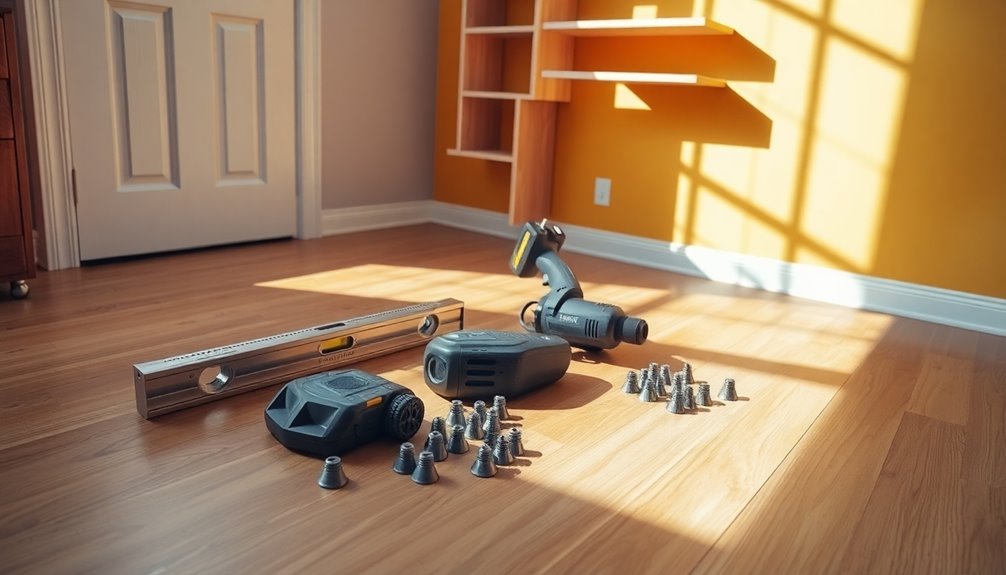
Securing furniture to the wall requires the right tools to ensure a safe and effective installation. First, you'll need a stud finder to locate the wall studs, as this is crucial for a secure attachment. A pencil is handy for marking both the wall and the furniture, while a tape measure ensures precision in your measurements. A drill with an appropriate drill bit is essential to create pilot holes, and a hammer may be necessary for tapping in nails or wall anchors.
For drilling and screwing, a power drill is vital, along with various drill bits to accommodate different wall types like drywall or masonry. Choose wood screws or drywall screws based on your wall material, and have a screwdriver or screwdriver bit ready for tightening. Additionally, using furniture anchors is essential for preventing tip-over incidents and ensuring the safety of your home.
You'll also need furniture straps, L-brackets, or wall anchors designed specifically for this purpose. Don't forget safety gear like safety glasses and a dust mask to protect yourself. Finally, a level helps ensure your furniture is straight, while spackling can patch any holes if needed. With these tools, you'll be well-equipped for a secure installation.
Locating Wall Studs Effectively
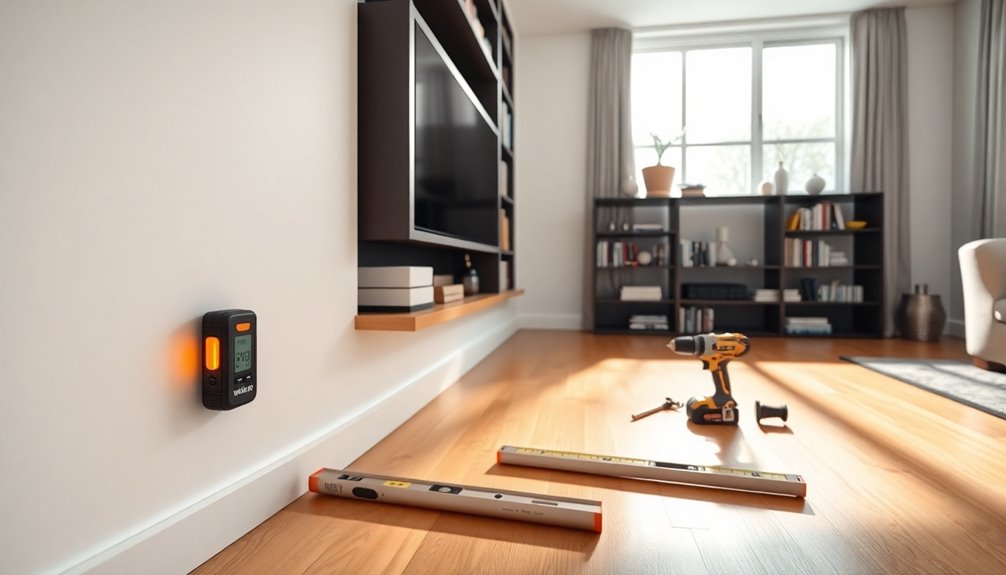
Locating wall studs effectively is crucial for securely anchoring your furniture. One reliable method is to use electrical outlets and switches as indicators. Most outlets are mounted to the side of a stud, so removing the switch plate can reveal the nail securing the box. From there, measure about 16 inches to find the next stud.
Another approach involves utilizing magnets. You can use a strong magnet to locate metal screws or nails holding the drywall to the studs. Simply attach the magnet to tape or dental floss and drag it across the wall. When it sticks, you've found a stud. Many stud finders also provide visual or audible signals when a stud is found, which can enhance your detection accuracy.
You can also measure from corners and trim. Generally, studs are spaced 16 inches apart, starting from the corner of the room. Check the baseboard for nail depressions to confirm stud locations.
Lastly, tapping the wall can help, too. Gently knock on the surface; a muffled sound indicates a stud, while a hollow sound means there's none. Drilling small holes near the baseboard can further verify stud presence. Using these methods, you'll effectively locate your studs for secure furniture anchoring.
Installing Wall Brackets
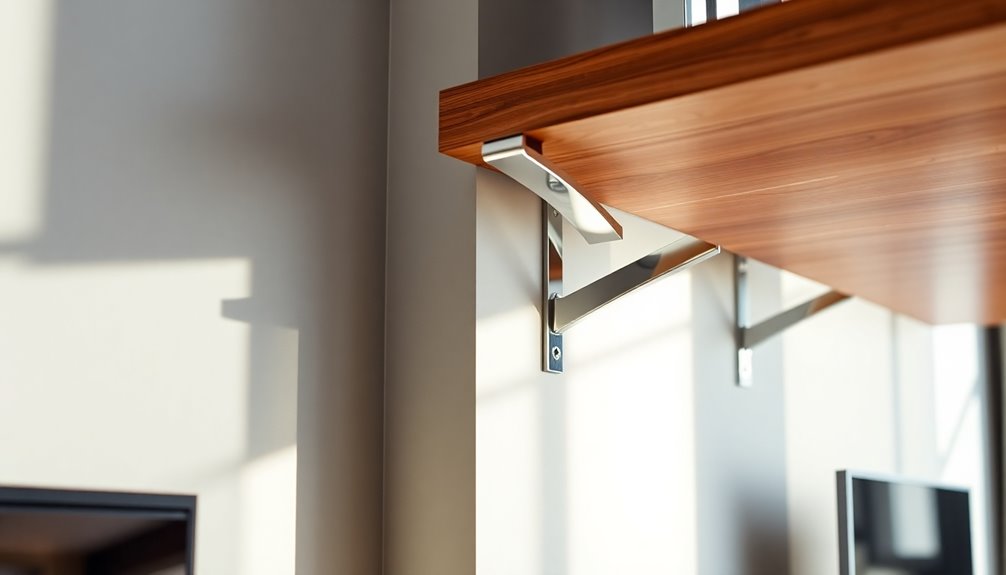
Installing wall brackets is a straightforward process that can significantly enhance the safety of your furniture. First, choose the right bracket based on your furniture type and wall material. Make sure it can support the weight of your furniture and consider moisture-resistant options like galvanized steel if needed. You might opt for L-brackets, adjustable spacer fixings, or anti-tip straps, depending on your specific requirements. Galvanized Steel Brackets are particularly useful in areas with high humidity, like bathrooms or kitchens, as they prevent rust and ensure durability.
Next, position the wall bracket just below the top of the furniture. Use a pencil to mark the wall along the stud for accurate placement. Align the bracket vertically or horizontally based on the furniture design, leaving a small gap for maneuvering.
When it's time to secure the bracket, use a 3/32 inch drill bit to create pilot holes in the studs. Attach the brackets with two long screws each, ensuring they're tightly secured into the studs for maximum stability. If you're not screwing into a stud, remember to use wall plugs or anchors. After installing, double-check that each screw is tight by testing them with a screwdriver, ensuring everything is securely in place before moving on.
Securing Brackets to Furniture
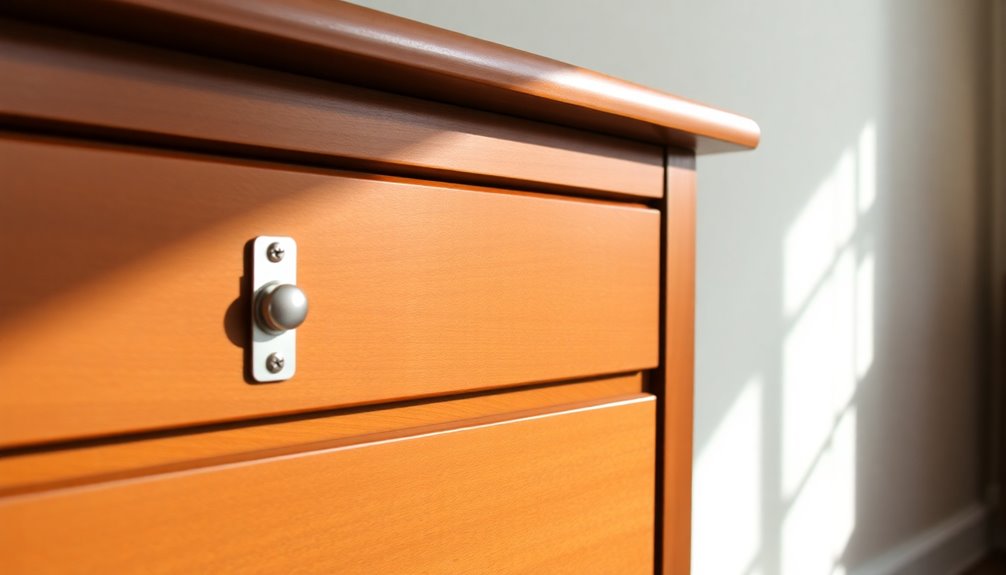
When attaching brackets to your furniture, it’s crucial to find the right location for maximum stability and support. Always aim to fasten brackets to solid wood rather than the thin back panel. Install the brackets as high as possible on the furniture, and remember, they don’t need to be centered; securing them to a thick piece of wood is more important. Before you start, mark where the bracket will go using the holes in the bracket as a guide. Additionally, ensure that the weight distribution on the furniture is balanced to further enhance its stability. Once the brackets are securely fastened, consider adding cushions for extra comfort, especially if you plan to use the sofa for extended periods. If you’re experiencing discomfort, learning how to relieve back pain on sofa can significantly improve your relaxation and enjoyment of the space.
Next, prepare your furniture by pre-drilling holes to prevent splitting. Use a drill with the right bit to create these precise holes, ensuring they align with the bracket's holes. If your furniture is larger, consider using multiple brackets for added stability. Before securing everything, confirm that the furniture is level.
Now, it's time to secure the brackets. Use wood screws that fit the material and thickness of your furniture. Tighten each screw by hand with a screwdriver to ensure they're secure. Lastly, double-check that the brackets are firmly attached, and test the furniture's stability to ensure it won't tip over. This way, you'll achieve a safe, stable setup. Additionally, securing furniture with brackets can significantly reduce the risk of furniture tip-overs, which is especially important for households with children.
Types of Furniture Anchors
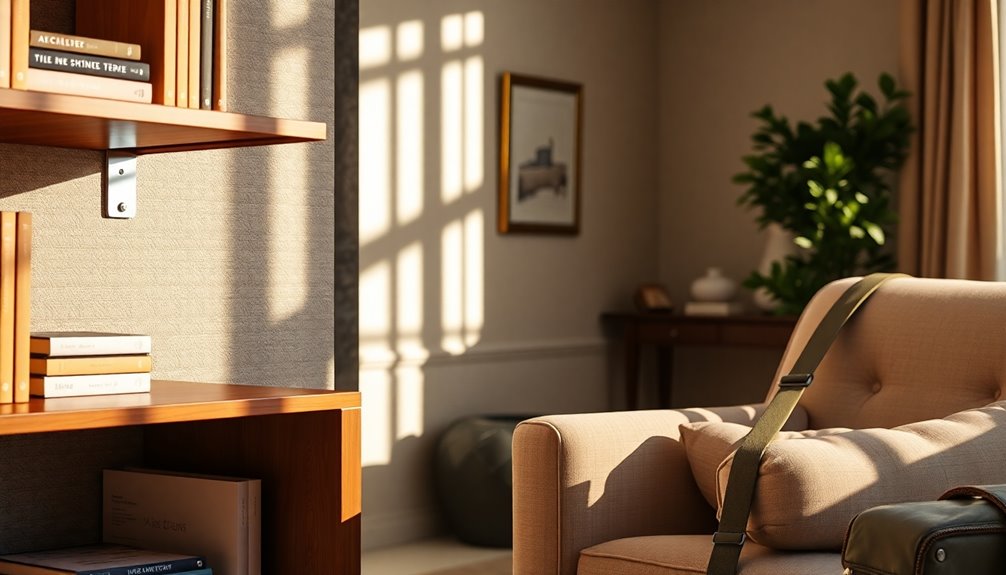
After securing the brackets to your furniture, it's important to choose the right type of anchor to ensure maximum stability. One popular option is furniture straps, which connect a wall bracket to your furniture using adjustable straps or cables. They're easy to install and can be adjusted after installation. Straps like the Simple Mount Furniture Anti-Tip Kit have been tested for strength, ensuring your furniture stays put. Additionally, many of these furniture stabilizer kits are designed with child safety features to protect your little ones from potential hazards.
L-brackets are another choice, fastening to both the wall and the top of the furniture. However, they can be trickier to install and need to be secured to a wall stud for stability. Be cautious if your wall has baseboards, as they may affect how closely the furniture sits against the wall.
If you're anchoring specific items like TVs, consider mounts designed for that purpose. These typically come with the necessary hardware and are essential for preventing heavy items from tipping over. Lastly, specialized anchor kits, like the Booda Brand Furniture Anchors, offer general use options that can withstand significant force, ensuring your furniture remains secure in any situation.
Step-by-Step Installation Process
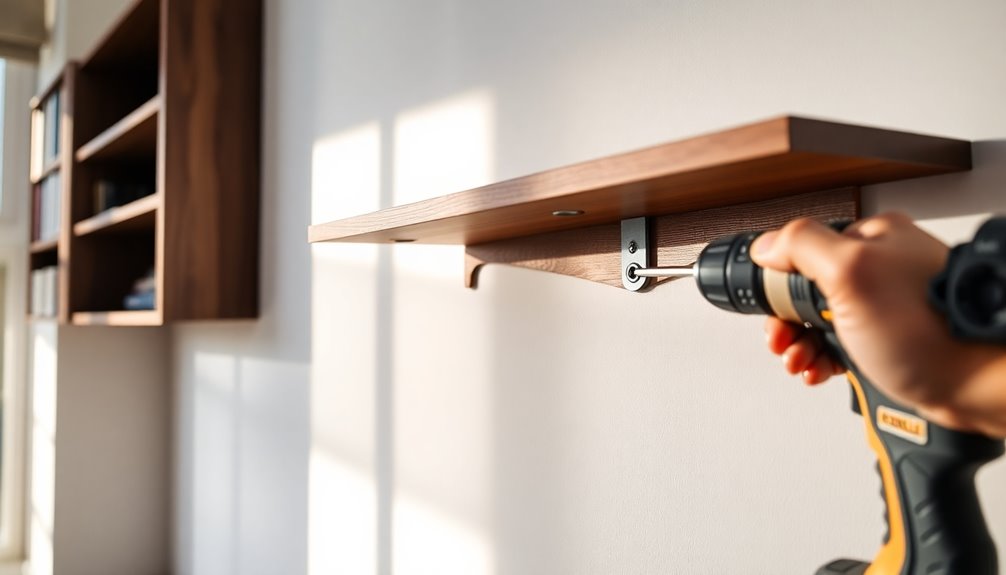
Securing your furniture to the wall might seem daunting, but breaking the process into manageable steps makes it straightforward. Start by moving the furniture against the wall and marking its top with a pencil. Ensure your marks on the wall align with the furniture and follow any manufacturer's instructions for bracket placement. Use a stud finder to locate wall studs and mark their outlines. Then, measure and mark where the anchors will go.
Next, drill pilot holes at your marked locations with a drill bit slightly smaller than the screws in your anchor kit. Insert the wall anchors securely, especially if using toggle bolts. If you're drilling into studs, use wood screws at least 2 inches long for a strong hold. For drywall, choose appropriate anchors. Make sure to use a stud finder to enhance the support of your installation.
Now, drill pilot holes in the solid wood at the top of your furniture and attach brackets or straps using screws. Make sure they're aligned and level. Finally, align your furniture with the wall-mounted brackets, securing it with the provided screws. Tighten everything down and test the stability by gently pulling or pushing the furniture. Regularly inspect the anchors to ensure they're still tight.
Safety Precautions to Consider
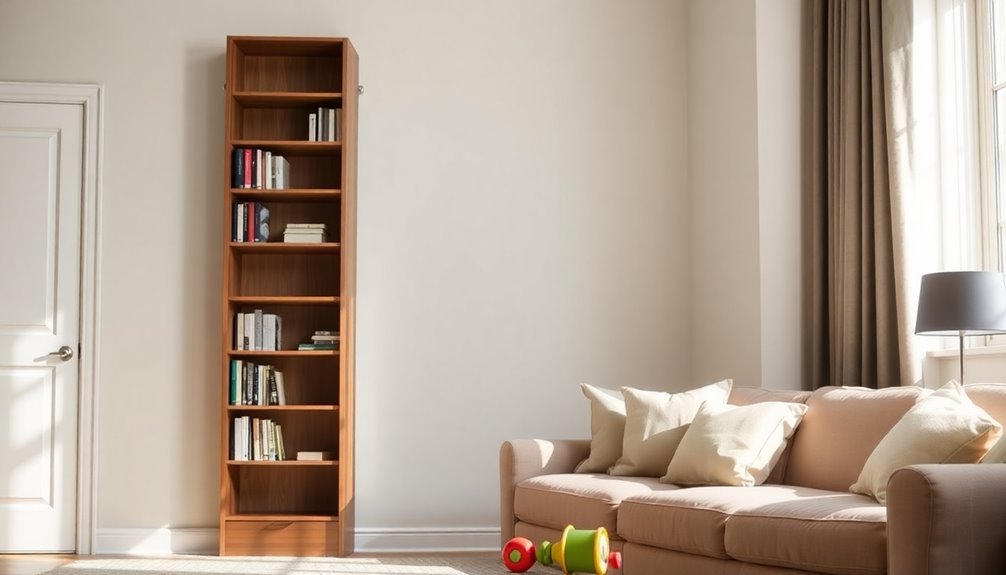
Taking safety precautions is essential to prevent furniture tip-overs, which can lead to serious injuries or even fatalities, especially among children and the elderly. Every hour, someone ends up in the ER due to injuries from tipped-over furniture, TVs, or appliances. That's why it's crucial to anchor all your furniture, regardless of its weight or height.
When choosing anchors, steer clear of plastic cable ties or zip ties, as they can break down over time. Opt for L brackets, angle braces, or products designed for earthquake safety, ensuring they're suited for your specific furniture and wall material. It's important to install anchors into solid wood rather than MDF or particle board to avoid pulling out screws. Additionally, remember to use two restraints for each furniture piece to maximize safety.
Use a stud finder to locate wall studs for the strongest attachment points, and if you're working with drywall without studs, employ toggle bolts. Regularly check your furniture restraints for any slack, and remove heavy items before anchoring. Always follow the manufacturer's instructions for anchor placement, and be vigilant about recalls, replacing any unsafe anchors immediately. Your diligence in these precautions can significantly enhance your home's safety.
Best Practices for Stability
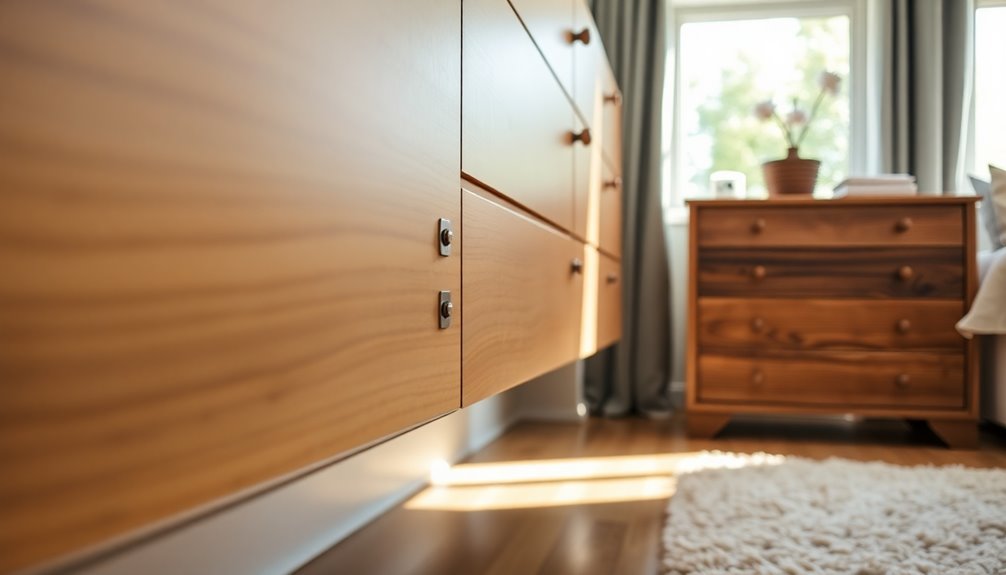
Implementing the right anchoring techniques can significantly enhance the stability of your furniture and prevent it from tipping over. Start by choosing anchoring devices specifically designed for the task. Avoid unreliable options like plastic cable ties or drywall anchors. Instead, opt for L brackets, steel cable style anchors, or heavy-duty furniture straps with metal attachments, ensuring they contain no plastic parts. When installing anchors, always secure them into solid wood on the back or top of the furniture. Use a stud finder to locate wall studs and attach the anchor directly to one. Never use plastic drywall anchors or toggles. Drill pilot holes in both the furniture and wall for a secure fit, using screws that are at least 2 inches long. Additionally, ensure that you pre-drill a hole in the furniture for the L bracket to achieve a more stable connection. For optimal stability, use at least two restraints per piece of furniture, especially for wider or stacked items. Secure the top piece to the base and then to the wall. Tighten the restraints at the end of the installation process to eliminate any slack. Regularly check that the restraints remain tight, and test each screw by hand to confirm a secure connection.
When to Hire a Professional
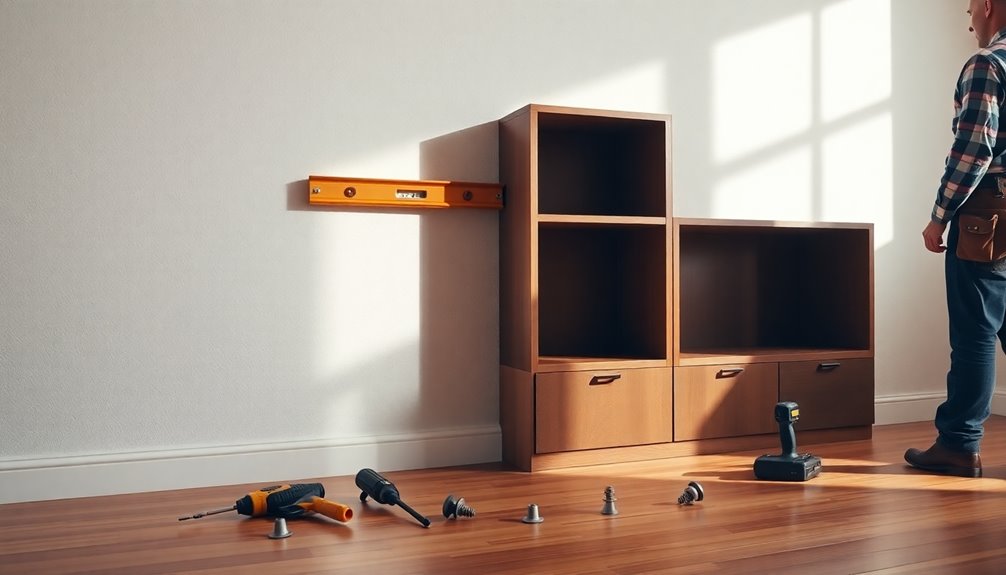
When it comes to anchoring furniture, knowing when to hire a professional can make all the difference in ensuring safety and stability. If you're dealing with complex tasks like anchoring to masonry or plaster walls, it's wise to seek expert help. These tasks often require specialized tools and skills that most DIY enthusiasts don't possess. Additionally, professionals possess extensive knowledge of various furniture assembly techniques, ensuring each piece is securely anchored.
If you lack the necessary tools, hiring a professional is a smart choice. They come equipped with everything needed, from power tools to specialized screws, saving you the hassle and expense of purchasing equipment you might only use once. Proper tool selection minimizes the risk of damaging both your furniture and walls.
Safety is another significant concern. If you're uncomfortable with climbing ladders or handling heavy items, it's best to let professionals take over. They're trained in safety procedures, reducing the risk of injuries like strains or accidents from improperly anchored furniture.
Lastly, consider the time and effort involved. Professionals can complete the job quickly and efficiently, allowing you to focus on other important tasks. If you want peace of mind and a job well done, hiring a professional is the way to go.
Frequently Asked Questions
What Types of Furniture Should I Secure to the Wall?
You should secure tall and heavy furniture like dressers, bookshelves, and armoires to the wall, as they're prone to tipping. TV stands and entertainment centers, especially when loaded with electronics, also need anchoring. If you have small children or pets, any freestanding cabinets or furniture near play areas are high-risk and should be secured. Remember, furniture with narrow bases is more likely to tip, so take extra precautions with those pieces.
How Can I Hide the Mounting Hardware After Installation?
To hide mounting hardware after installation, you can choose discreet locations for your brackets and straps. Use shorter straps to minimize visibility and adjust them tightly. Install L brackets flush against the wall for a cleaner look. Consider using wall putty to fill any holes and paint over them for a seamless finish. Finally, ensure everything is level, so the hardware blends in with your decor, maintaining an aesthetically pleasing environment.
Can I Use Adhesive Strips Instead of Brackets?
You can use adhesive strips instead of brackets for lighter items, but keep in mind their limitations. They're great for quick applications without drilling, but they generally can't support heavy furniture. Make sure the surface is clean and dry for optimal adhesion. If you have tall or heavy pieces, it's safer to combine adhesive strips with brackets for added security. Always check weight limits to ensure your furniture stays secure.
How Often Should I Check the Stability of Secured Furniture?
You should check the stability of secured furniture at least once a year, ideally between October and February before the wet season. After significant events like heavy rain or earthquakes, it's essential to inspect the anchors to ensure they're still secure. Regularly look for loose screws or signs of wear, and if you notice any issues, tighten the anchors or consult a professional to maintain safety and stability.
Are There Specific Brands Recommended for Furniture Anchoring Kits?
When choosing furniture anchoring kits, consider brands like Simple Mount, Booda, and QuakeHOLD. Simple Mount's anti-tip kit is strong and easy to install, while Booda offers a budget-friendly option that works well on both wooden and metal studs. QuakeHOLD is top-rated for its resistance against significant forces. Avoid Lomily and Qdos, as they failed in tests. Prioritize safety with reliable brands to ensure your furniture stays secure.
Conclusion
Securing your furniture to the wall is a simple yet vital step to ensure safety in your home. By following the steps outlined, you can prevent accidents and protect your loved ones. Remember to use the right tools, locate wall studs, and double-check your installations for maximum stability. If you ever feel unsure, don't hesitate to reach out to a professional for help. Your peace of mind is worth it! Stay safe and enjoy your well-secured space.
